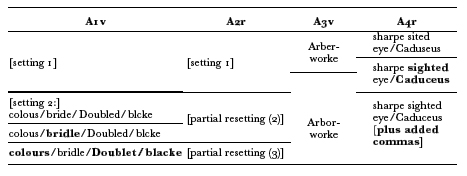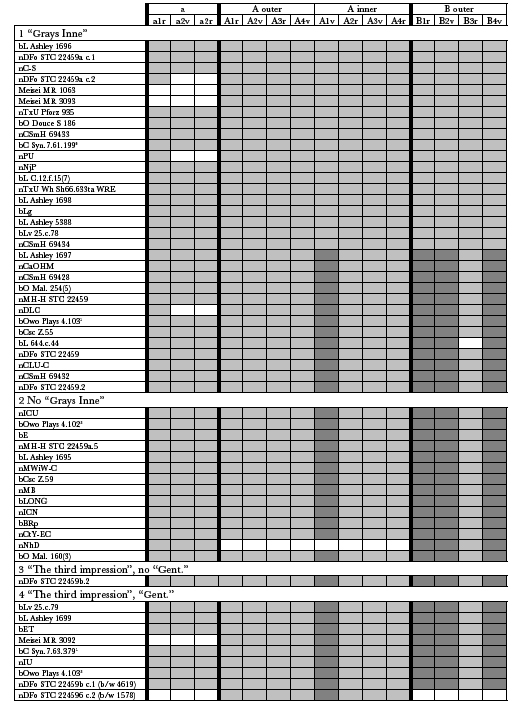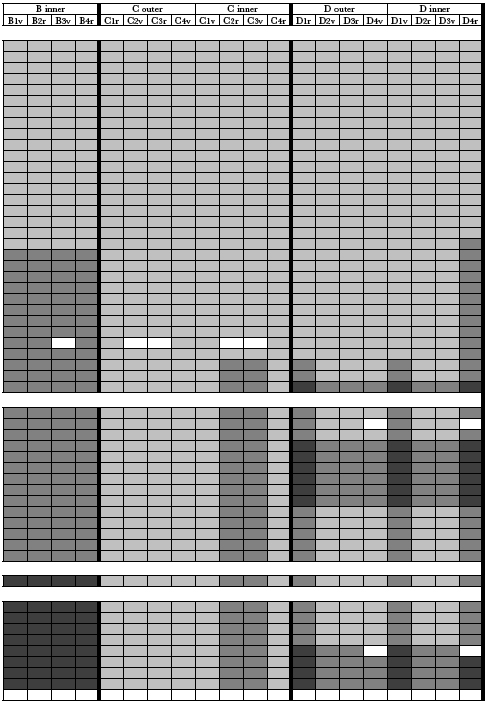| JAMES SHIRLEY'S TRIUMPH OF PEACE:
ANALYZING GREG'S NIGHTMARE
by
STEPHEN TABOR
| ||
§1. Main Settings
Table 1 shows, in shades of gray, the distribution in surviving copies of
the
completely different settings of each page. The rows of the table correspond
to
the copies or reproductions I have examined, grouped by the four title-page
vari-
ants which are separated by the horizontal white bands. The columns
represent
the pages of each copy grouped by quire and forme. One can immediately
see
what perplexed the earlier bibliographers. Some settings persist throughout
the
print history: the outer formes of quires A and C, for instance, and even
the
title page (a1r), remain substantially the same with relatively minor
variants.
Other pages go through as many as three settings. Most of the new
settings do
not line up with changes on the title page. The concept of "edition"
as applied
to the whole book, and the normal role of the title page as the primary
taxo-
nomic organizer, go out the window here. So does any hope of dealing with
the
book quirewise, or even formewise. Only a page-by-page analysis will
allow
us to specify the relationships among copies.
As it happens, this patchwork of settings (taken in conjunction with the
vari-
ants they contain) works in our favor when we set out to put all the states,
from
major to minor, into chronological order. Let us take the example of quire
A
inner forme, where page A2r goes through two partial resettings, A1v gets
one
complete resetting, and the other two pages exhibit only stop-press
corrections.
In table 2, the heavy horizontal line separates the completely
different settings
of A1v, while the lighter lines separate partial resettings or
more minor altera-
tions. The relative positions of the lines between columns show
the points of
introduction of new states, either simultaneously with changes on
other pages or
independently from them. We have no immediate basis for deciding
the order
in which some of these occurred. However, since the forme is the basic
unit of
printing, these four pages must all live their lives in the same
direction: a prov-
able sequence of variants on one page imposes an obligation on
the sequences
of the others.

A4r, in its single setting, shows progressive improvement in spelling
and
punctuation. In the first wave of correction, "sharpe sited" becomes
"sharpe
sighted" and "Caduseus" becomes "Caduceus". In the next wave, the addition
of
commas to a listing of architectural features helps to improve the sense. On
A3v,
the correction of "Arber-worke" to "Arbor-worke", occurring part-way
through
the second state of A4r, follows the same order. If we accept this
sequence of
states for these two pages, the other two (A1v and A2r) must follow
suit. There-
fore, setting 1 of both A1v and 2r does indeed come first, a fact
that we would
otherwise have difficulty proving. Setting 2 of A1v then goes
through two waves
of correction that lock partial resettings 2 and 3 of A2r into
order. When, some
twenty-five years ago, I began to sort through all of the states
of ToP, I was pleas-
antly surprised to find most of them
clicking into place pretty readily in this same
way. I have recorded the
rationales for the order of states in appendix 1, though
I would not encourage the
reader to venture into that thicket quite yet.
The important thing to note in table 1 (the table of editions of the whole
book)
is that there appears to be an orderly progression of settings of the
constitu-
ent sheets. The various settings of one quire do not mix randomly with
settings
of other quires. As the quire-breaks always fall at the same points in
the text in
all the states, copies could in theory have been assembled from sheets
of what-
ever combinations of settings were available at the gathering stage. The
lack of
random mixing implies discrete stages of production and collation, and
provides
one argument against the theory of simultaneous setting that has
prevailed until
now. Only the late states of quire D show a more promiscuous
behavior; I
will explain this in §8B.
The title-page variants, though seeming to dance to their own drummer, at
least
dance in the same direction as the variants in quires A-D. In the earliest
copies
of the title (fig. 1[A]), the "O" in "OF" in line 3 is sound. A small
accident
soon dents the top of the O, and this damaged type persists through all
of the
subsequent states. Reassuringly, the "third impression" title pages are
found only
in copies having the latest states of the text, and we can see that the
unique copy
of title 3, with its dangling comma after "Grayes-Inne", is just an
uncorrected
version of title 4. Quire "a", therefore, shows a rational order of
variants that also
tracks the evolution of the other quires, even if the
title-page changes are out of
phase with those of the text pages.
Although, after we become familiar with table 1, we discern some
comforting
regularities, we are left with the question of why some pages were
reset and others
were not. The mystery deepens when we look more closely at the
pages which
retain at least 50% of their original settings. TOP shows the normal pattern of
stop-press corrections found in most books
of the hand-press period. But we also
encounter two phenomena which are unusual:
(1) pages on which only the page
number is reset, where no correction was
required, and (2) pages on which blocks
of text in a particular type style
(usually italic) are reset—again with no substan-
tive changes to the
reading—while the other portions remain untouched.
The seemingly capricious page-number resettings turn out to be a powerful
tool
for reconstructing the sequence of events in John Norton's shop during
the
printing of ToP. Once we understand what motivated
them, we will be in a better



 |
position to interpret the equally puzzling replacement of blocks of text on
some
pages.
| JAMES SHIRLEY'S TRIUMPH OF PEACE:
ANALYZING GREG'S NIGHTMARE
by
STEPHEN TABOR
| ||

